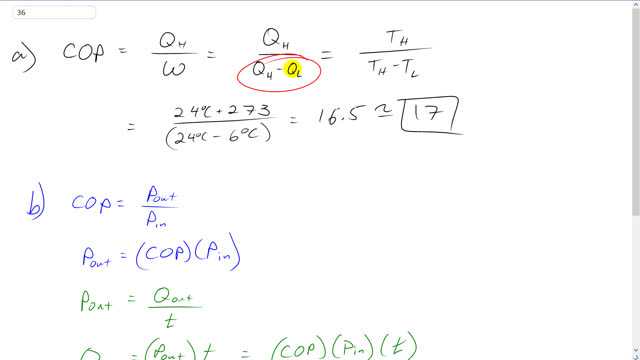
- What is the coefficient of performance of an ideal heat pump that extracts heat from air outside and deposits heat inside a house at ?
- If this heat pump operates on 1200 W of electrical power, what is the maximum heat it can deliver into the house each hour? See Problem 35.

In order to watch this solution you need to have a subscription.
This is Giancoli answers with Mr. Dychko. Coefficient of performance for a heat pump is the amount of heat energy delivered to the high temperature reservoir divided by the work that it takes to make that happen. And the work is gonna be the total energy delivered to the high temperature reservoir minus the amount of energy that it brought along with it from the low temperature reservoir. And since this is an ideal situation, these heats are proportional to the temperatures and we could write a little proportionality constant in front of each of these temperatures but it's gonna cancel on top and bottom so I didn't bother doing that and so we have T H over T H minus T L. So it's 24 degrees Celsius for the high temperature plus 273 to convert it into Kelvin and divided by 24 minus six. And these don't need to be converted into Kelvin because there is a subtraction here and the plus 273 for each of the temperatures will just get subtracted away to make zero so we're left with 24 minus six there, coefficient of performances is 17. For Part B, coefficient of performance is the rate at which energy is delivered to the high temperature reservoir divided by the rate at which energy is consumed and to make that happen. So power output divided by power input, you could say. and we'll solve a power output by multiplying both sides by power in and so a power output is coefficient of performance times P in. Power output is also the total energy delivered per time and so we multiply both sides by T to get the energy delivered and power output is coefficient of performance times power input and so that's 16.5 times 1200 watts power consumed in making this movement of heat from the low temperature to the high temperature and this is the rate at which work is being done in other words and times by the time, one hour times 3600 seconds per hour and we get 7.1 times ten to the seven joules, it's the total energy output.